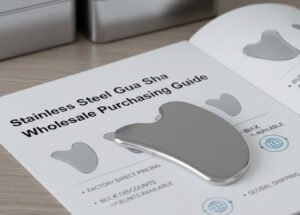
Gua Sha’s journey from Traditional Chinese Medicine (TCM) into the global beauty scene has been remarkably swift. In just a few years, it has gained worldwide popularity—driven by rising demand for natural beauty and wellness, as well as the viral power of social media. But have you ever asked yourself: Does Gua Sha work?
Today, we’ll explore this question through a closer look at what Gua Sha is, the science behind it, its real-world effects, and answers to some frequently asked questions.
- What Exactly Is Gua Sha?
- Does Gua Sha Work? Where Science Meets Experience
- Gua Sha Back: Does Gua Sha Work?
- Gua Sha FAQs
What Exactly Is Gua Sha?
Origins and Principles of Gua Sha
The origin of Gua Sha is varied and somewhat disputed, but the most widely accepted theory traces it back to Bian Stone Therapy, a traditional Chinese healing practice. Over centuries, it evolved into the Gua Sha we know today. Historical records show that Gua Sha has been used for over a thousand years.
The theory behind Gua Sha is rooted in the TCM concept of qi (vital energy) and blood flow. A famous TCM saying goes, “Where there is free flow, there is no pain; where there is pain, there is no free flow.” In other words, pain and discomfort often stem from blockages in the flow of qi and blood. Gua Sha, through repeated scraping motions, helps to release these blockages and stimulate better circulation, which in turn can promote healing and relieve pain.
Face vs. Body Gua Sha: Key Differences
Facial and body Gua Sha differ significantly in terms of tools, techniques, and pressure applied. Using body Gua Sha methods on the face can actually cause harm instead of benefits. Understanding these differences is essential for effective and safe use.
1. Treatment Area:
Face: Targets the face and neck; focuses on enhancing skin tone, reducing puffiness, and anti-aging.
Body: Focuses on large muscle areas like the back and shoulders; aims to relieve tension and fatigue
2. Tool Type:
Face: Small, delicate tools often made of jade or rose quartz, suitable for sensitive areas
Body: Larger and harder tools designed to cover broader surfaces with more pressure.
3. Technique & Pressure:
Face: Gentle upward strokes to boost circulation and skin firmness.
Body: Deeper pressure to ease muscle knots and stiffness.
4. Expected Results:
Face: Improved complexion, reduced puffiness and fine lines, better facial contour.
Body: Pain relief, improved blood flow, elimination of cold and damp from the body.
5. Recovery Time:
Face: Mild redness that fades within hours.
Body: Possible bruising (“sha marks”) that may take a few days to a week to fade.
Does Gua Sha Work? Where Science Meets Experience
The effectiveness of Gua Sha can be assessed from multiple perspectives, including clinical studies, expert opinions, and user experiences. However, outcomes may vary depending on individual health conditions and goals.
Scientific and Clinical Findings:
Improved Circulation: Studies show Gua Sha boosts local blood flow and lymphatic drainage, which helps deliver oxygen and nutrients to the skin and muscles, enhancing skin health and vitality.
Reduced Muscle Tension: Research supports Gua Sha’s ability to relax tight muscles, especially in the back and shoulders, effectively reducing pain and stiffness.
Expert and User Feedback:
Experts: TCM practitioners and physical therapists commonly acknowledge Gua Sha’s benefits for muscle relief and detoxification. They do caution that correct technique and pressure are crucial to avoid skin damage.
Users: Many report enhanced skin glow and firmness, particularly on the face. Others praise its effectiveness in relieving neck and shoulder fatigue.
Different Outcomes for Different Needs
Beauty: Facial Gua Sha enhances skin tone, reduces puffiness, softens fine lines, and lifts contours—ideal for those seeking firmer, healthier-looking skin.
Detox: Stimulates lymphatic flow, aiding in toxin removal and reducing swelling.
Relaxation: Body Gua Sha is excellent for muscle relaxation, making it ideal after long workdays, workouts, or stressful situations.
Gua Sha Back: Does Gua Sha Work?
Back Gua Sha is one of the most widely used forms of this therapy. The back has a broad surface area and contains many acupuncture points and energy pathways. Due to modern lifestyles—prolonged sitting, stress, or poor posture—people often suffer from tension in the lower back and trapezius muscles. Gua Sha helps ease these problems.
Benefits of Back Gua Sha:
Relieves stiffness and soreness in the back.
Alleviates fatigue by boosting circulation and lymphatic drainage, restoring energy—especially effective post-work or post-exercise.
Expels cold and damp: According to TCM, these elements can settle in the back and lead to discomfort. Gua Sha helps remove them and ease joint or muscle pain.
Professional vs. DIY:
Back Gua Sha is best done by trained professionals, as it involves deeper knowledge and technique than facial Gua Sha. Incorrect use may lead to adverse effects or injury.
Gua Sha FAQs
1. How long does it take to recover after Gua Sha?
Face: Minimal downtime; often usable daily.
- Body: Depends on skin sensitivity and sha marks (red spots from capillary breakage). Wait for marks to fade before repeating treatment.
2. How quickly does Gua Sha show results?
Beauty: Requires regular use (typically over a month) to see lasting results—varies by individual.
Muscle relief: Often immediate improvement after one session.
Cold or fever: Noticeable relief usually within 1–2 days.
3. Who should avoid Gua Sha?
Those with open wounds or skin injuries.
Pregnant women (especially in abdominal or lower back areas).
People with blood disorders or circulation issues.
Heart disease patients, especially those with hypertension or other cardiovascular conditions.
Individuals with sensitive or allergy-prone skin.
Those with acute infections or inflammation.
Cancer patients, particularly those undergoing chemotherapy or radiation.
People with liver or kidney dysfunction.
Extremely weak or fatigued individuals.
Children and infants (unless approved by a healthcare provider).






